Vegan challah! This rich and eggy pastry has never been better. Made with chickpea flour eggs for a light and airy enriched dough that is baked to perfection with a golden crust. Delicious!
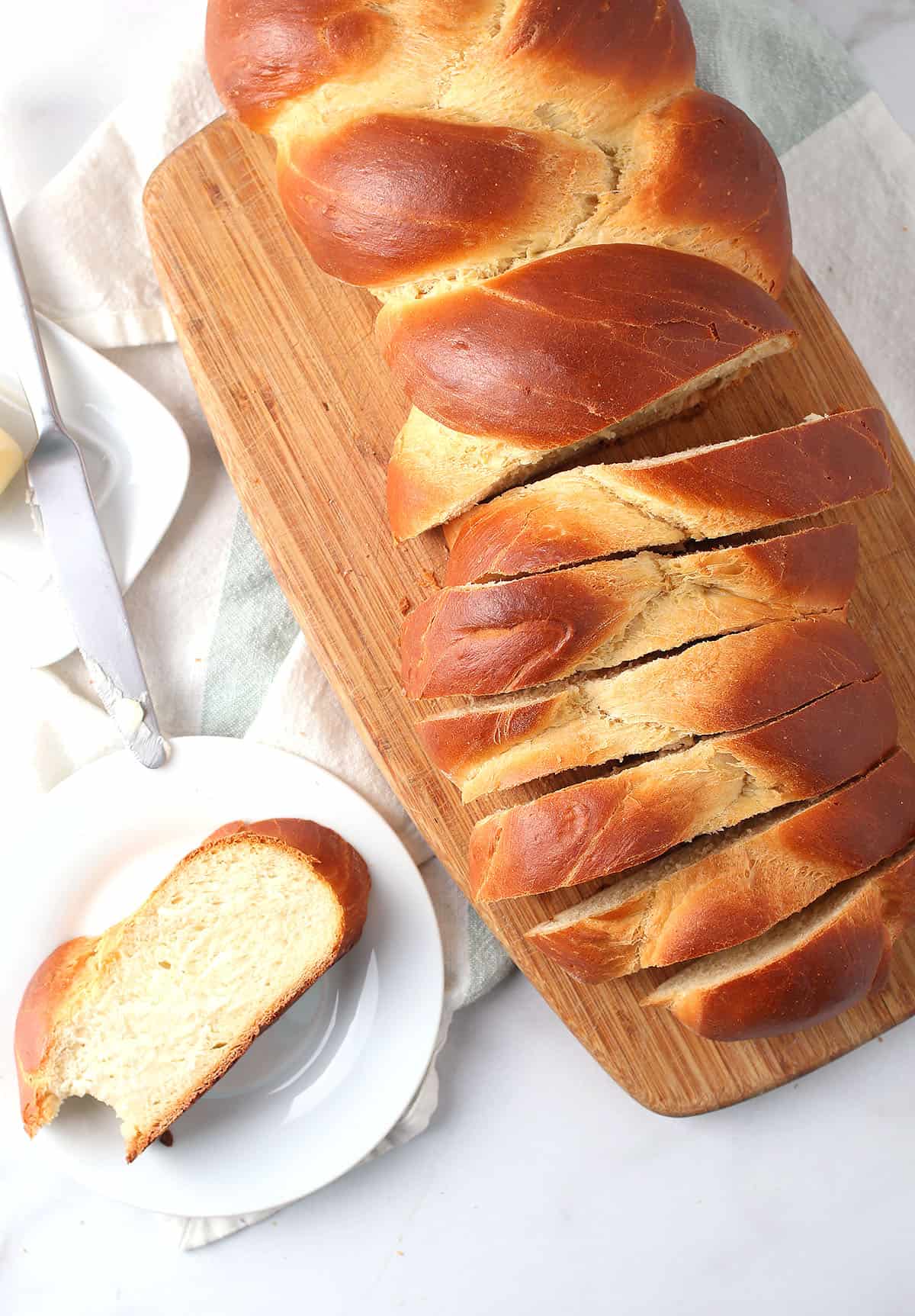
Disclosure: This post may contain affiliate links.
Years ago, I was a bread baker at a trending cafe and restaurant in Michigan. Sadly, the restaurant is now closed, but in the years that I baked bread for that wonderful place, I learned valuable lessons that I will take with me for the rest of my life.
One of the most popular breads we baked was our homemade challah. We used it for everything! It was the base of our french toast, the bread of many of our sandwiches, and pastry of choice for bread pudding.
Later, I moved onto other bakeries and continued making and perfecting challah. However, it wasn't until I quit working for other people and started working for myself that I started experimenting with vegan challah.
This recipe was one of the first recipes I created for this website, way back in 2012. Since then it has been made many times by my readers (that's, you!).
The recipe has been well loved and for that reason, I decided it was time to give it a little makeover.
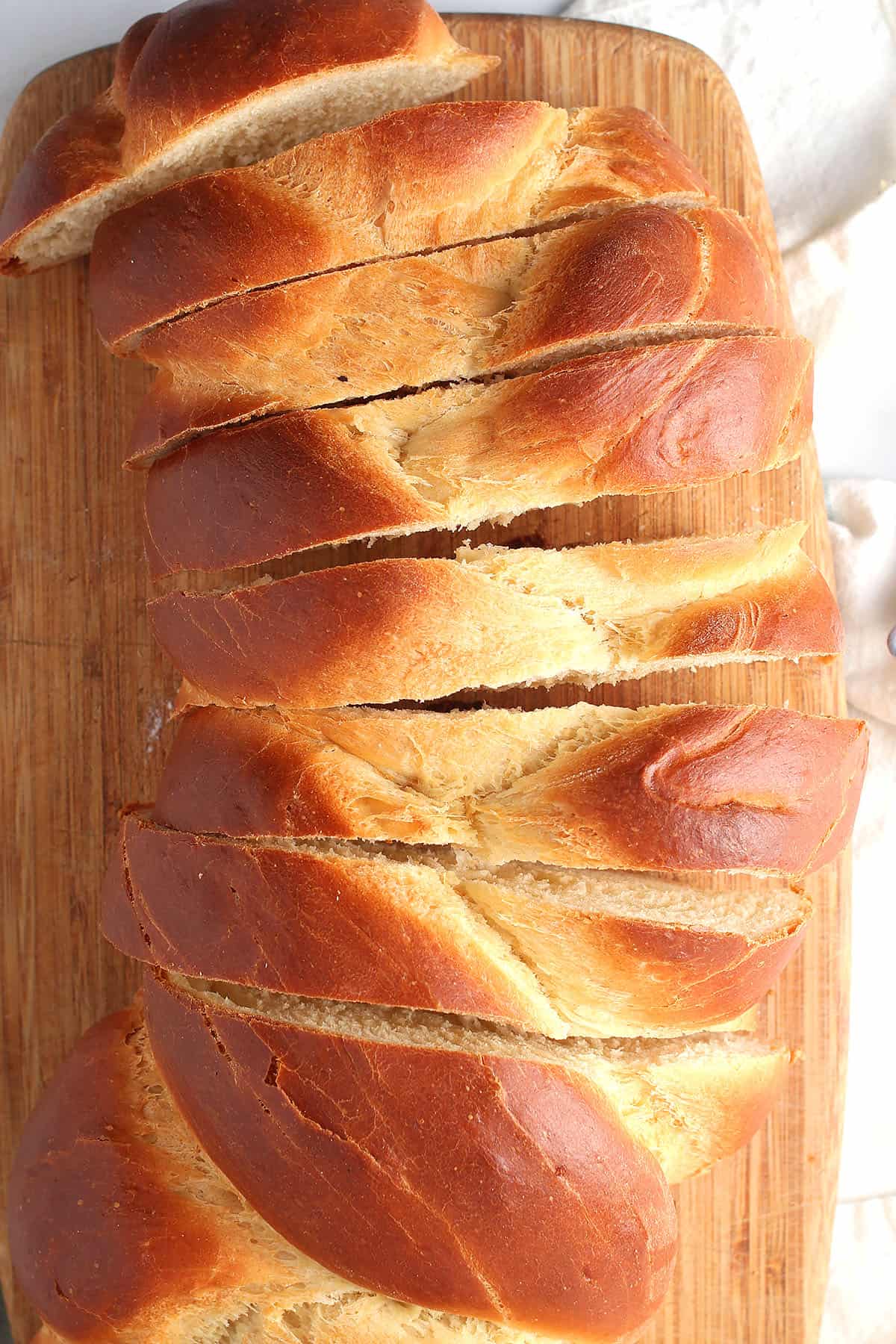
Ingredients & Substitutions
Challah is a soft, slightly sweet, enriched bread. The bread relies heavily on eggs and fat to give it that decadent texture. It took me several years to perfect this recipe and, friends, I think you're going to love it!
Here is everything you need.
- Active Dry Yeast - You can also use instant yeast if that's what you have on hand. The two are interchangeable in function. The only difference is that active dry yeast needs to be dissolved in a liquid to activate whereas instant yeast can be mixed right into the dough.
- Granulated Sugar - Check out my guide to vegan sugars.
- Chickpea Flour - This is used as the egg replacement. I love the chickpea flour eggs because they have a serious binding and leavening powder, similar to that of eggs which gives the bread its structure and lightness. Chickpea eggs are also completely flavorless meaning it won’t affect the taste of the bread itself. This is the only egg replacer that I recommend.
- Olive Oil - Most often I use olive oil but this recipe is also great with melted vegan butter.
- Salt
- All-Purpose Flour - I've had several people ask me if they can make this recipe gluten-free. I haven't yet tried using gluten-free flour, so I can't recommend it. If you've tried this recipe with a gluten-free flour blend, let us know how it turned out for you in the comment section below.
Step-by-Step Instructions
Step One - Make the Dough
Enriched yeasted dough often sounds far more intimidating than it is. While it takes time, the process is quite simple.
To start, place the yeast, 2 teaspoons of sugar, and warm water in the bottom of your bowl. Set aside for 10 minutes to allow the yeast to activate.
Pro Tip: It is very important that your water is warm but isn’t above 120F. Too hot and it will kill the yeast, making it unable to activate.
Slowly add the oil and chickpea egg, whisking while adding. Add the remaining sugar and salt. While mixing, gradually add the flour until dough begins to come together, but is still soft. This will be between 3-4 cups of flour depending on your altitude. The dough should be soft but not sticky.
Mix your dough for about 5 minutes in the stand-up mixer until it is well kneaded. Flip it out onto a floured surface and roll it into a ball. Place the dough in an oiled bowl, cover, and place in a warm area to let rise.
Step Two - Shape the Dough
After about 60 minutes, the dough should have doubled in size. Punch the dough down to release the air. Cover it and let it rise for an additional 30 minutes.
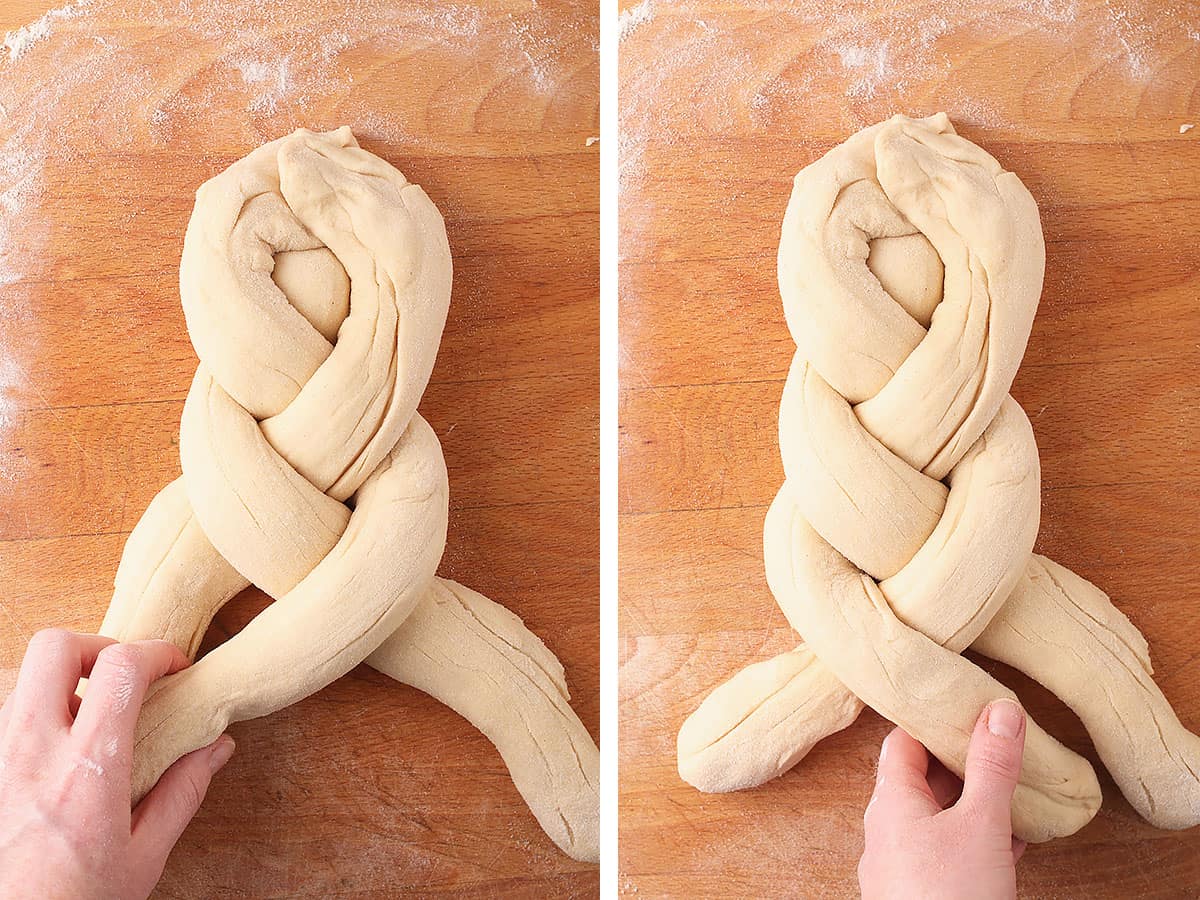
Flip the dough on a floured surface and cut into three equal pieces. A baking scale is the best way to ensure the pieces are even. Roll each piece into long strands (about 18 inches) and let sit for 5 minutes.
Once the dough has rested, braid it together, tucking in the ends underneath the loaf. Here is a good video tutorial.
Cover and let rest the dough rest for an additional 30 minutes.
Step Three - Bake the Bread
Preheat the oven to 375 degrees F. Brush loaf with soy milk one final time and bake 30-35 minutes, until the top is golden brown and a firm crust has formed.
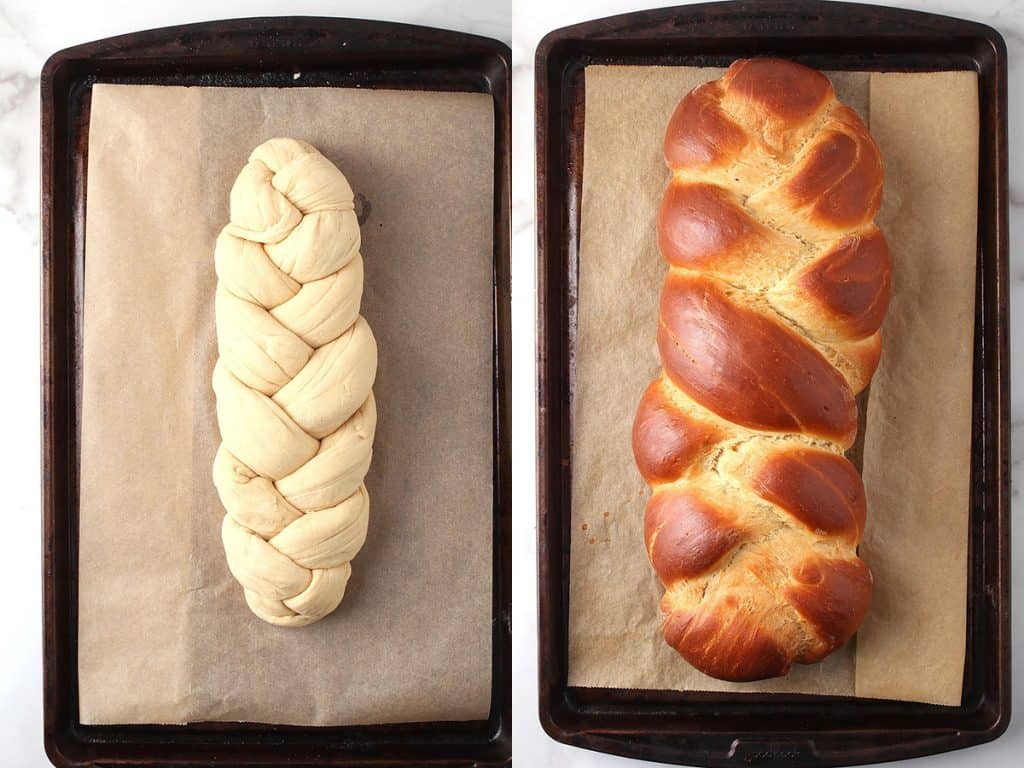
Remove from the oven and let it cool 10 minutes on a baking sheet before transferring it to a wire cooling rack to cool completely.
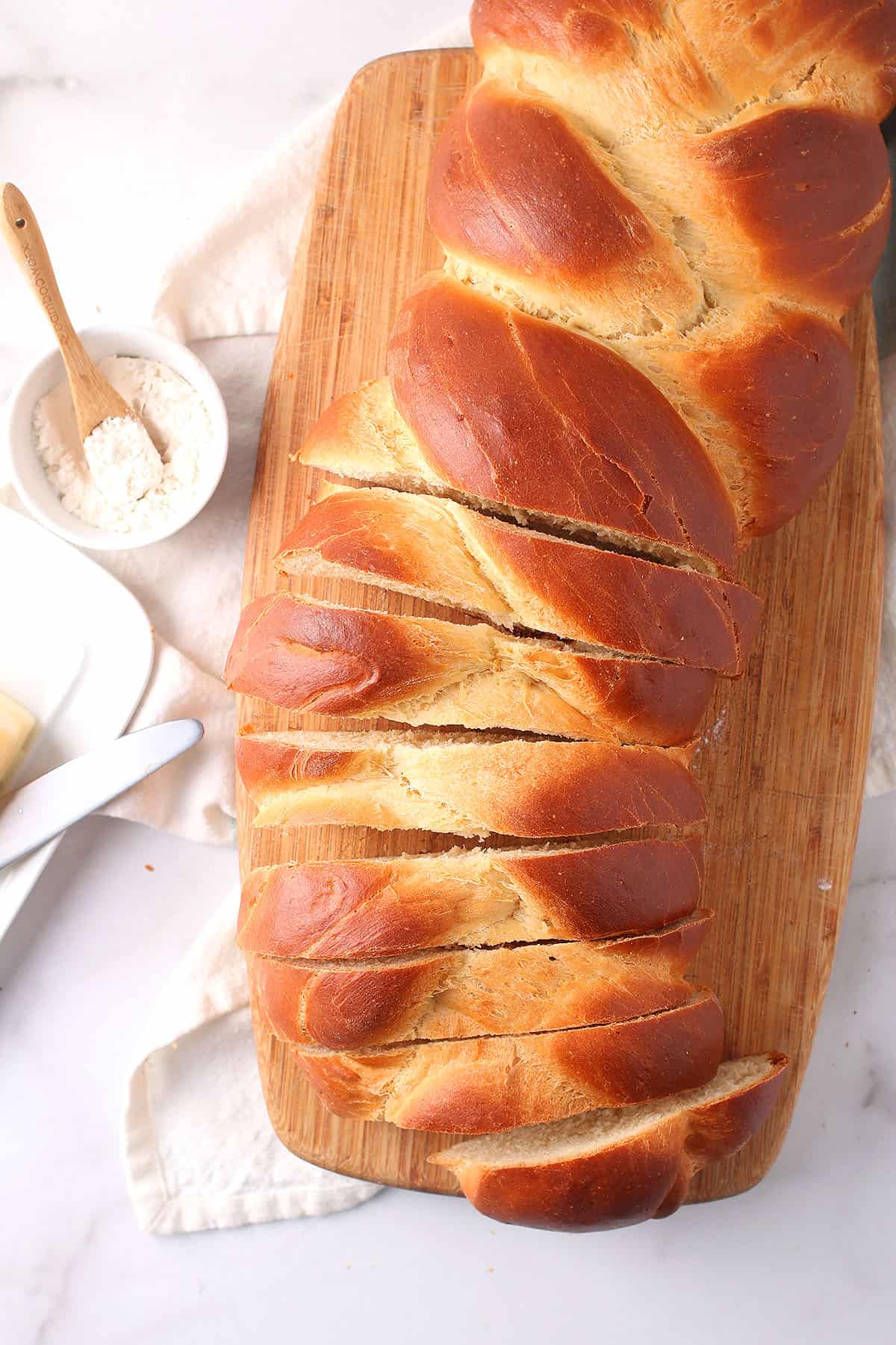
Serving and Storing
Serving - Serve this bread as a snack or part of a complete meal. Homemade Challah is perfect for French Toast or for sandwiches such as these Portobello Sandwiches with Caramelized Onions.
Storing - Store this bread in a plastic bag at room temperature for up to 5 days or in the freezer for up to 2 months.
Tips and Tricks
- Activate your yeast properly. To do this, make sure your yeast is not expired and the water is warm but not too hot. Otherwise, the yeast will not activate and you will not get a pillowy rise on the bread.
- Add flour slowly. The dough should be soft but not so sticky that you can’t handle it. This recipe calls for 3-4 cups of flour. Add it ½ cup at a time until you’ve achieved the desired dough.
- Let the dough rise in a warm place for 1 ½ – 2 hours, until the dough has doubled in size.
- Don’t skip the 2nd rise. Let your dough rise for an additional 30 minutes for a soft, melt-in-your-mouth texture.
Frequently Asked Questions
Unfortunately no. Chickpea flour is uniquely high in protein giving it binding and leavening powers that all-purpose flour simply cannot. You can find chickpea flour in most well-stocked grocery stores in the gluten-free aisle or you can pick some up online.
Yes, it can! If you want to make this sweet bread the night before, prepare the bread following the instructions below to the point of the 2nd rise. Once the bread is shaped, cover it with plastic wrap and place it in the refrigerator overnight. The next morning, remove the dough from the refrigerator 30 minutes prior to baking.
No! While a stand-up mixer makes this recipe much easier, you can certainly make this bread by hand. Simply combine the ingredients in a large mixing bowl and knead it together on a floured surface. Knead the dough for 10 minutes before the first rise.
I actually haven't tried this and so I can't recommend this but I am asked this question fairly frequently. If you've tried this recipe with a gluten-free flour blend, let us know how it turned out for you in the comment section below.
More Vegan Bread Recipes
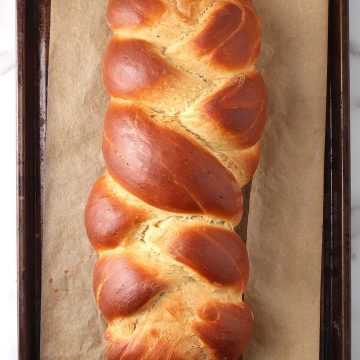
Vegan Challah
Ingredients
- 2 ½ teaspoon active dry yeast
- ¼ cup + 2 tsp sugar
- 1 cup water
- ½ cup chickpea flour + ½ cup water
- ¼ cup olive oil
- 1 ½ teaspoon salt
- 3-4 cups all-purpose flour
Instructions
- In a stand-up mixer, with the dough hook attachment, whisk together yeast, 2 teaspoons sugar, and 1 cup lukewarm. Set aside for 5 minutes to allow the yeast to activate and sugar to dissolve.
- In a food processor or blender, blend together the chickpea flour along with ½ cup water until it is thick and foamy. This is your chickpea egg. Set aside.
- With the motor running, slowly add the oil and chickpea egg into the yeast mixture. Add the remaining ¼ cup of sugar and salt. Whisk together. Gradually add the flour, one cup at a time, until the dough begins to come together. Turn the speed to medium-high and knead for 5 minutes until dough begins clearing the sides and forms a smooth ball. You want the dough to feel soft, but not sticky.
- Remove the dough and place it in an oiled bowl. Cover and let rise in a warm place for one hour, until doubled in size. Punch the dough down to remove any air bubbles, re-cover, and let rise an additional 30 minutes.
- Turn the dough on a floured surface and cut into three equal pieces. Roll each piece into long strands (about 18 inches) and let sit for 5 minutes. Now, braid the challah. Here is a good video tutorial.
- Brush the loaf with soy milk and set aside to rise for 30 more minutes, until dough slowly pushes back when an indentation is created with your finger.
- Preheat the oven to 375 degrees F. Brush loaf with soy milk on final time and bake 30-35 minutes, until the top is golden brown and a firm crust has formed.
- Let cool completely before slicing.
Notes
- Activate your yeast properly. To do this, make sure your yeast is not expired and the water is warm but not too hot. Otherwise, the yeast will not activate and you will not get a pillowy rise on the bread.
- Add flour slowly. The dough should be soft but not so sticky that you can’t handle it. This recipe calls for 3-4 cups of flour. Add it ½ cup at a time until you’ve achieved the desired dough.
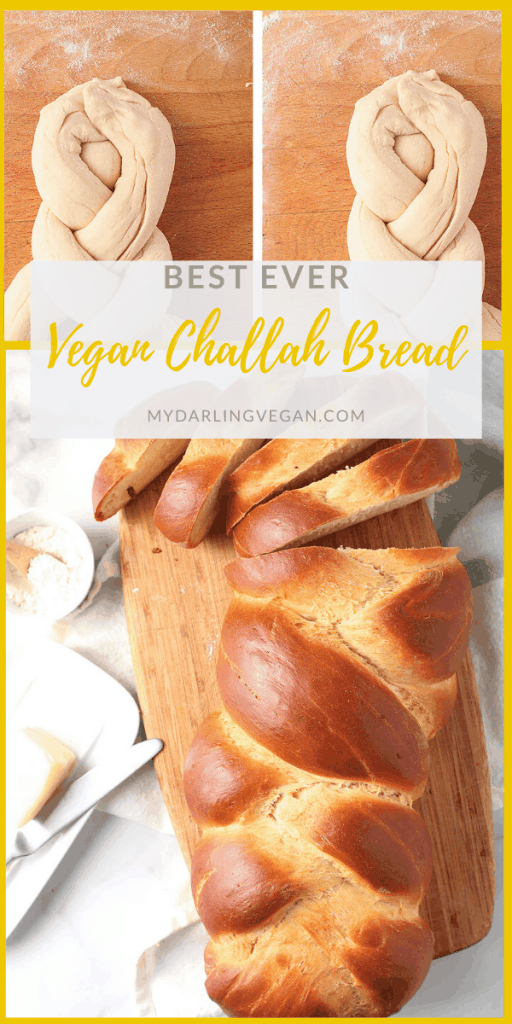
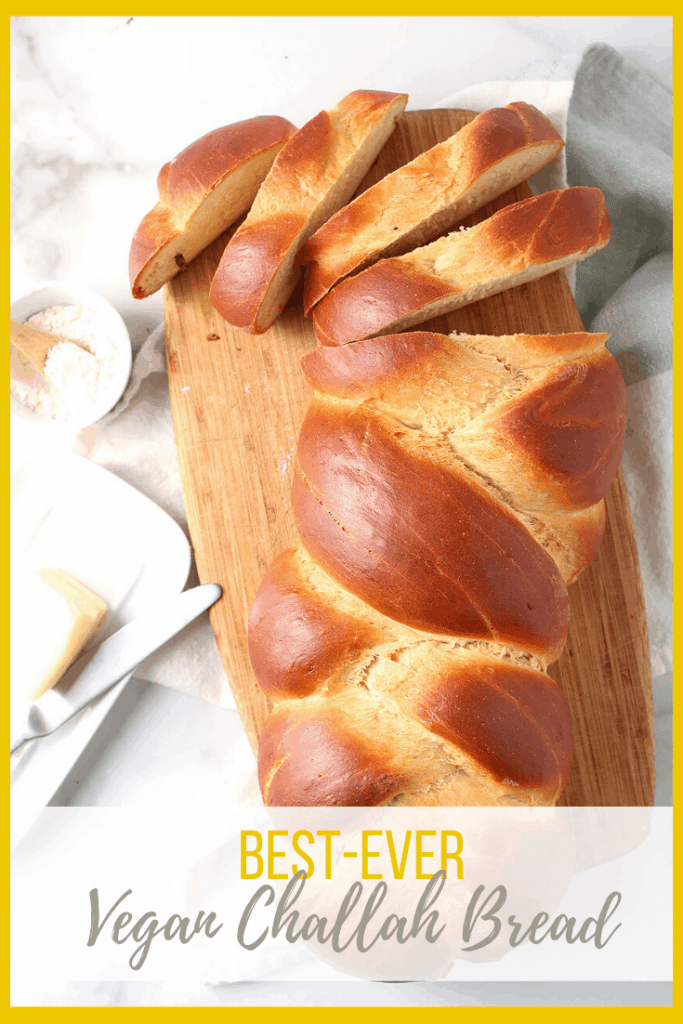
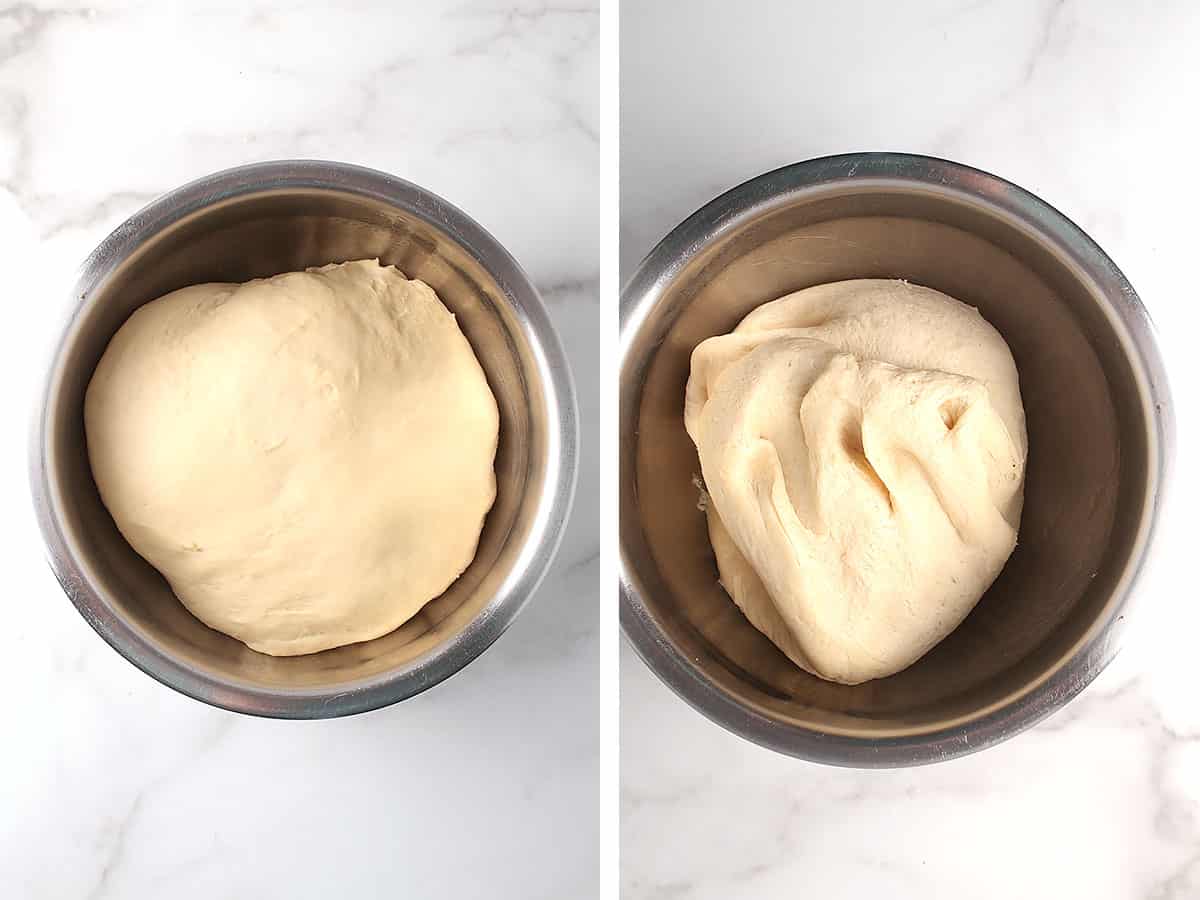
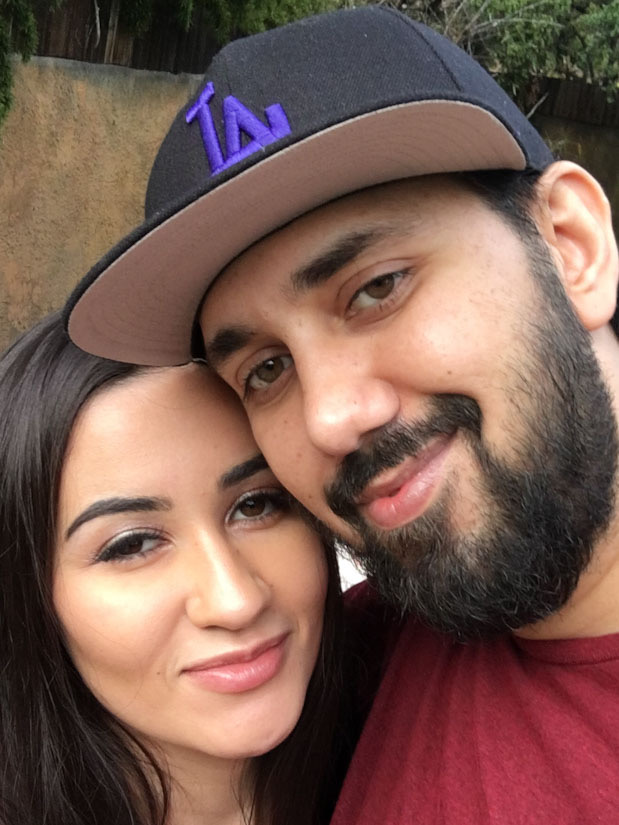 Hi, we’re Shayne and Kristina! I’m the chef and editor here at My Darling Vegan, and Kristina is the photographer and writer. Together we’re carrying on this space with the same focus on easy, flavorful vegan recipes that anyone can enjoy at home. Check out our
Hi, we’re Shayne and Kristina! I’m the chef and editor here at My Darling Vegan, and Kristina is the photographer and writer. Together we’re carrying on this space with the same focus on easy, flavorful vegan recipes that anyone can enjoy at home. Check out our
Natalie says
I have a question about the chickpea egg. Is it necessary to mix it with water before adding to the recipe, or can I add my chickpea flour to the dry ingredients and the water to the wet ones? I'm mostly curious because I want to try it out in some other recipes.
I'm also curious if you have a general guideline for using chickpea flour as an egg replacer. How many eggs (roughly) does the 1/2 cup replace in this recipe? Thanks!
Suzanne says
Can I use chia seeds to replace chickpea flour?
Vanessa says
Is medium-high a 6/7 on the mixer? When I made this last time, it came out better. Recently, the dough rose but the baked bread was flatter looking than my previous attempt. I’m not sure if I didn’t have enough flour (I added all four cups) or needed to mix longer (but I mixed at about a 7 for the full five minutes). I didn’t want to go longer because I was concerned about over kneading. Or maybe I didn’t prove long enough?
Kathy L says
This is one of my favorite bread recipes. I use a hand blender to combine the chickpea flour and water. I also replace a tablespoon of olive oil with a habanero garlic olive oil for a little zing.
Hina says
Is it possible to use aquafaba as the egg substitute in this recipe?
JOSIE says
I made this for Easter morning - very good! I made it in the bread machine & it came out well.
Carol says
The traditional challah recipes sometimes use a bit of saffron for colour. Which is vegan of course. I haven’t tried it yet but I dug see why it wouldn’t work.
Ruchama Burrell says
I am an observant Jewish woman, also a vegan. This looks like it might be a good alternative to the recipe we use most of the time where pureed squash replaces the eggs. However, for a Shabbat meal, where challah is part of the ritual, there must be two loaves. Your recipe would make two very small loves. Some bread recipes can be doubled, others not. It would be helpful if you included a note about doubling. Also, from experience caution against adding flour to make the dough less sticky. Just make sure the surface you are braiding on and your hands are well floured. I've shared the vegan recipe I use with others. Those who find the results disappointing have felt the need to add extra flour.